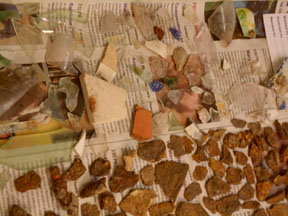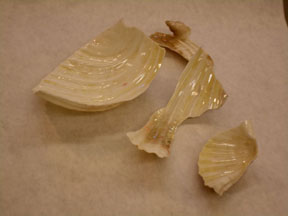Piecing Together Chicago History: The Archeology Practicum
Text and Photos by Sarah Miller, Class of 2015
"The history of Chicago is very interesting. I'm well-versed in my hometown's history, but I don't know as much about Chicago. Living here and working on the Charnley House is giving me wonderful opportunities to learn more about Chicago's past," said Emma Kinsley, a student in Dr. Rebecca Graff's Archeology Practicum.

In 2008, Dr. Graff (AM '01, PhD '11) led the first archaeological dig of
Jackson Park, site of the 1893 World's Columbian Exposition. Through her archeology class, twenty students got to unearth some Chicago history.
Since then, Graff finished
her PhD and led an excavation at the Charnley-Persky House, a
National Historic Landmark. The house was built from 1891-92 under the
supervision of Louis Sullivan and then-apprentice Frank Lloyd Wright.
The Society of
Architectural Historians' Pauline Saliga initially
asked Graff to lead an excavation at the site in 2008. In 2010, Graff performed the excavation in conjunction with DePaul
University's Urban Archeology Program.
Graff is now using artifacts from the site for the Archeology Practicum. In addition to gaining hands-on lab experience, students will learn about Chicago History, American History, and
Materials History.
The students are
working with artifacts that date from the 1890's to the 1930's. They
vary in composition and color, and include animal bones, porcelain,
broken bottle necks, pieces of tin cans, and fragments of a shell-shaped
plate.

Shell-shaped plate from Charnley-Persky Excavation
"Studying these artifacts is useful because they
provide insight in the foods people ate and the types of medicines,
plates, cups, and decorations they used during that time," said Graff. First-year Kinsley said, "In one bag I was washing recently there were
four pieces from a bottle that had an embossed label on it. I'm very
interested in trying to figure out where and when the bottle was made
and what it held."
One of the class' assigned texts, The Gold Coast and the Slum by sociologist Harvey Zorbaugh (PhD '29), explores the unique dynamic within the neighborhood.
The Gold Coast neighborhood, where the site is located, was developed in the 1880's and 1890's by Chicago's elite. "In the neighborhood, very wealthy and very poor people lived together side-by-side. Sorting these artifacts allows us to see this changing neighborhood," said Graff.
Olive Oil Bottle from Charnley-Persky Excavation
Graff notes that the Charnley-Persky House is considered to be the first work
of modern architecture. In building the house, Sullivan disregarded the
standards of Victorian architecture and designed a house with minimal
detail and an open floor plan.
The excavation is a wonderful partnership to supplement Social History with Architectural History, according to Graff. Though they left a beautiful house, not much is known about the Charnley family. "The Charnleys did not leave any written records, which was unusual for wealthy people of that time...They only lived [in the house] for ten years - we don't have any pictures of them or even any diaries," said Graff.
Graff has already been asked to do another dig at the house in 2013, and she hopes to continue her study of the site for a number of years. "I am fascinated with Chicago and probably will be for the rest of my life. I enjoy working with students and sharing my experiences with Chicago with them," said Graff.
DIG DEEPER
• Chronicle Article on World's Columbian Exposition Excavation
• Charnley-Persky House and the Society of Architectural Historians
• Video from DePaul University on the dig at the Charnley-Persky House
• The Gold Coast and the Slum from the University of Chicago Press
Categories
Chicago history , Study0 TrackBacks
Listed below are links to blogs that reference this entry: Piecing Together Chicago History: The Archeology Practicum.
TrackBack URL for this entry: https://blogs.uchicago.edu/cgi-bin/mt/mt-tb.cgi/649

YOUR INFORMATION needs and comments about this site are important to us. If you have a question that you can't find an answer to or you have a suggestion or comment, please share it with us. We'll make sure it is directed to the appropriate office or department.